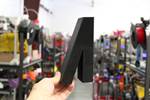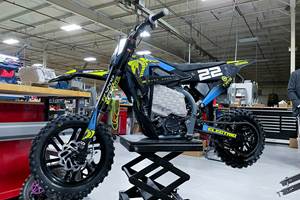What stops an inventor from becoming a manufacturer? Or an invention from becoming an available product?
One answer: the mold moment. The tooling moment. Or, closely related, the machining moment. At some point, the inventor has to commit to getting the product produced, and traditionally that has meant commissioning a mold or making some similar commitment to allowing a manufacturing contractor to tool up and set up to manufacture some initial (quite possibly large) order quantity. This commitment entails not just cost, but also a stopping point to innovation — locking in the product design for the sake of the tooling, for the sake of manufacturing — as well as being prepared to inventory the production that comes from this moment until the market can be stirred into buying. For many, many potential new products, this is too much; the commitment is too great. The unknowns about the market combined with the cost and commitment of manufacturing mean the mold moment is where the idea ends.

A single path to production that leads through a “mold moment” early on might prevent an inventor from ever getting to market. With additive manufacturing, there are now more routes to take, more paths forward from idea to manufactured product.
But additive manufacturing (AM) potentially puts off this moment. The established paths to production all include a mold moment, or something like it, quite early on. With AM, there are now different paths. By allowing for production without tooling, with minimal initial investment, additive manufacturing can avoid the mold moment, tooling moment or machining moment — or it can relocate that moment to a different part of the path that comes much later in the journey.
I began by talking about an inventor as the originator of a product, but I am not just referring to the lone genius sketching on a napkin. Companies are inventors, too. Innovative OEMs are organizational inventors, developing specialized new products for the sectors they serve, and these more organized inventors face the very same mold moment themselves. The expansion of production options will help them as well. The chance to come to moments of major manufacturing investments at a much later point on the path will allow many more of their ideas to become real. This benefit represents a value of additive that deserves to be highlighted, and lately we have been doing that. Recently posted articles explore the new paths to production that have opened because of AM.
Looking to metal parts: Now that AM is an option for initial or full production, when should CNC machining become the mode of production, if it even does at all? One way to find the answer is to explore competing options at the outset, letting additive and machining experts propose the best paths they see. Meanwhile, some metal parts have their own mold moment — notably cast parts for which the mold is made of sand. 3D printing in sand is providing new paths here as well, including options that use conventional and 3D printed foundry tooling in tandem. And when metal AM is the full production method, still there are various paths. The part that begins on one metal 3D printer might enter full production on another. The part that begins on a small metal 3D printer might enter full production on a large one.
With plastic parts, meanwhile, increasingly there are options for avoiding the mold altogether. Through its access to a printer farm involving hundreds of polymer-extrusion 3D printers running at once, the new startup Angled can provide for plastic part production at practically any volume — small quantities to large — without a tooling investment. The service is a fit to the lone inventor mentioned previously, and it is already producing products from independent creators like this. However, similar paths are available to organizational, industrial inventors as well. One major contract manufacturer has taken steps to make its distributed network of industrial 3D printers available to a wider range of customers. Keeping this AM capacity busy will allow this manufacturer to build on that network, ensuring that its paths to production continue to expand.
Related Content
How Norsk Titanium Is Scaling Up AM Production — and Employment — in New York State
New opportunities for part production via the company’s forging-like additive process are coming from the aerospace industry as well as a different sector, the semiconductor industry.
Read MoreNew Electric Dirt Bike Is Designed for Molding, but Produced Through 3D Printing (Includes Video)
Cobra Moto’s new all-electric youth motocross bike could not wait for mold tooling. Parts have been designed so they can be molded eventually, but to get the bike to market, the production method now is additive manufacturing.
Read MoreAluminum Gets Its Own Additive Manufacturing Process
Alloy Enterprises’ selective diffusion bonding process is specifically designed for high throughput production of aluminum parts, enabling additive manufacturing to compete with casting.
Read MoreCasting With Complexity: How Casting Plus 3D Printing Combine the Strengths of Both
Aristo Cast is advancing a mode of part production in which casting makes the part, but 3D printing enables the geometry.
Read MoreRead Next
Commercializing Sand 3D Printing in the New Tech Belt
Youngstown-area Humtown Products supplies both conventional and 3D printed sand cores and molds to foundries around the world. But sand tools for castings may be only the beginning.
Read MoreFor AM and Machining to Work Together, Let Them Compete
A medical device maker establishes a center of excellence for product and process development in which additive manufacturing and CNC machining both challenge and complement one another.
Read MoreAngled Makes It Possible for Anyone to Launch a 3D Printed Product
The online store utilizes open capacity at its sister 3D printer farms for on-demand production with no startup costs, allowing designers to sell physical products as easily as digital ones.
Read More






















